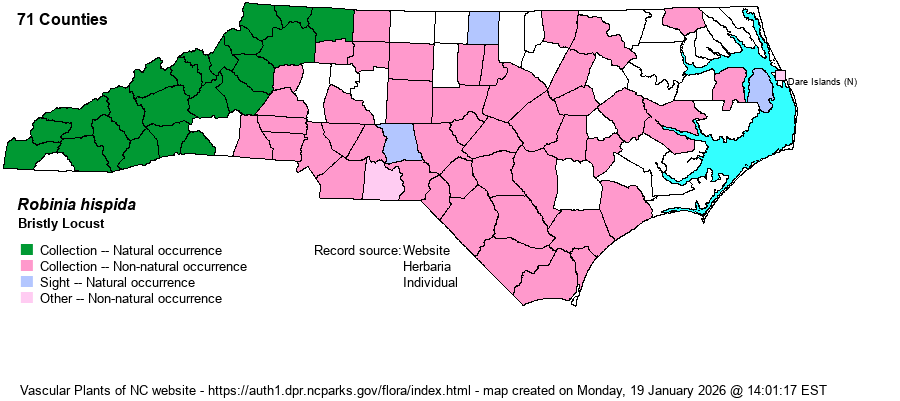| Author | L. | |
| Distribution | This species, which consists of numerous taxa (varieties), probably had a native range only in the Mountains and likely into the Piedmont foothills. However, it easily escapes to disturbed areas, and it now occurs over most of the Piedmont and in much of the Coastal Plain. It is mainly absent, even as escapes, in the eastern Coastal Plain.
The original range was probably limited to the Southern Appalachians -- NC, SC, GA, TN, and VA (according to Weakley 2018). However, the species widely escapes, and it is now found widely across most of the eastern U.S.
| |
| Abundance | Infrequent to locally fairly common in the Mountains, but uncommon over the Piedmont, and rare to very uncommon in the western Coastal Plain. Very rare farther eastward. Even though it has been recorded in nearly all Mountain and western Piedmont counties, it is not often encountered in the field. | |
| Habitat | Formerly it probably was a species of open, upland forests and dry slopes, and present on exposed ridges and outcrops. However, in the state it is now most commonly seen on roadbanks and roadcuts, in thickets, and other brushy, disturbed places. It does occur in some sandhill sites. As it is rhizomatous, where present it almost always is found in fairly extensive or dense colonies. |
| Phenology | Blooms in May and June; fruits from July to October. | |
| Identification | The nominate variety of the species is a deciduous shrub growing to 5-9 feet tall. It has the typical, 9-15 leaflets of other locusts but it is easily identified by the abundance of long reddish bristles all over the stems and flower clusters, deterring any attempts to pick or collect a twig! When in bloom, the shrubs are heavily covered in bright rose-pink inflorescences that easily catch your attention as you are driving past a stand of the species along a roadside or roadbank. The other forms (varieties) listed below are not as hispid/bristly, however. See identification keys for additional help. | |
| Taxonomic Comments | All references consider Robinia hispida to consist of numerous varieties/forms, but there is little agreement on how many and which taxa are included. NatureServe and Weakley (2018) consider NC to contain four varieties: 1) the nominate var. hispida, which is widespread in the state; 2) var. fertilis, a very poorly known form in the southern Appalachians but with many NC occurrences; 3) var. kelseyi (formerly known as Robinia kelseyi), a rare form in the higher mountains but ranging to Piedmont foothills; and 4) var. rosea (formerly known as Robinia boyntonii), a rare to uncommon form in the lower mountains and Piedmont foothills and monadnocks. The Dwarf Locust (R. nana), here considered as a valid species, is also often included within this large group as R. hispida var. nana.
| |
| Other Common Name(s) | Rose Locust, Rose Acacia, Moss Locust | |
| State Rank | S4 | |
| Global Rank | G4 [G5] | |
| State Status | | |
| US Status | | |
| USACE-agcp | | |
| USACE-emp | | |

